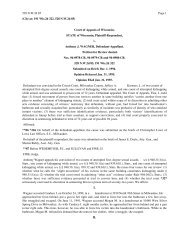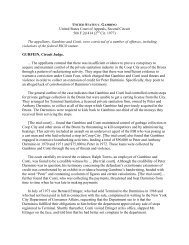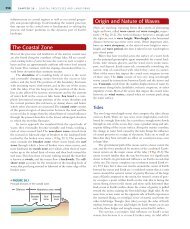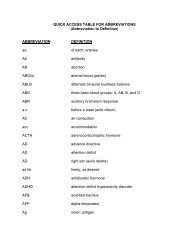Electrolytic-1-E
Electrolytic-1-E
Electrolytic-1-E
Create successful ePaper yourself
Turn your PDF publications into a flip-book with our unique Google optimized e-Paper software.
37K ELECTROGRAVIMETRIC METHODS<br />
A convenient example of an electrogravimetric method of analysis is the simultaneous<br />
determination of copper and lead in a sample of brass. Additional information<br />
concerning electrogravimetric methods is found in Section 22C.<br />
37K-1 The Electrogravimetric Determination of Copper<br />
and Lead in Brass<br />
Discussion<br />
This procedure is based on the deposition of metallic copper on a cathode and of lead<br />
as PbO 2 on an anode. As a first step, the hydrous oxide of tin (SnO 2 xH 2O) that<br />
forms when the sample is treated with nitric acid must be removed by filtration. Lead<br />
dioxide is deposited quantitatively at the anode from a solution with a high nitrate ion<br />
concentration; copper is only partially deposited on the cathode under these condi-<br />
11 From T. S. Light and C. C. Cappuccino, J. Chem. Educ., 1975, 52, 247.<br />
#
tions. It is therefore necessary to eliminate the excess nitrate after deposition of the<br />
PbO 2 is complete. Removal is accomplished through the addition of urea:<br />
6NO 6H 5(NH2) 2CO S 8N2(g) 5CO2(g) 13H2O Copper then deposits quantitatively from the solution after the nitrate ion concentration<br />
has been decreased.<br />
PROCEDURE<br />
Preparation of Electrodes<br />
Immerse the platinum electrodes in hot 6 M HNO 3 for about 5 min (Note 1). Wash<br />
them thoroughly with distilled water, rinse with several small portions of ethanol,<br />
and dry in an oven at 110°C for 2 to 3 min. Cool and weigh both anodes and<br />
cathodes to the nearest 0.1 mg.<br />
Preparation of Samples<br />
It is not necessary to dry the unknown. Weigh (to the nearest 0.1 mg) 1-g samples<br />
into 250-mL beakers. Cover the beakers with watch glasses. Cautiously add about<br />
35 mL of 6 M HNO3 (use the hood). Digest for at least 30 min; add more acid if<br />
necessary. Evaporate to about 5 mL but never to dryness (Note 2).<br />
To each sample, add 5 mL of 3 M HNO3, 25 mL of water, and one quarter of a<br />
tablet of filter paper pulp; digest without boiling for about 45 min. Filter off the<br />
#<br />
SnO 2 xH 2O, using a fine-porosity filter paper (Note 3); collect the filtrates in tall-<br />
form electrolysis beakers. Use many small washes with hot 0.3 M HNO 3 to remove<br />
the last traces of copper; test for completeness with a few drops of NH 3(aq). The<br />
final volume of filtrate and washings should be between 100 and 125 mL; either<br />
add water or evaporate to attain this volume.<br />
Electrolysis<br />
With the current switch off, attach the cathode to the negative terminal and the<br />
anode to the positive terminal of the electrolysis apparatus. Briefly turn on the<br />
stirring motor to be sure the electrodes do not touch. Cover the beakers with split<br />
watch glasses and commence the electrolysis. Maintain a current of 1.3 A for<br />
35 min.<br />
Rinse the cover glasses, and add 10 mL of 3 M H2SO4 followed by 5 g of urea<br />
to each beaker. Maintain a current of 2 A until the solutions are colorless. To test<br />
for completeness of the electrolysis, remove one drop of the solution with a<br />
medicine dropper, and mix it with a few drops of NH3(aq) in a small test tube. If the<br />
mixture turns blue, rinse the contents of the tube back into the electrolysis vessel,<br />
and continue the electrolysis for an additional 10 min. Repeat the test until no blue<br />
2 Cu(NH3) is produced.<br />
4<br />
3<br />
When electrolysis is complete, discontinue stirring but leave the current on.<br />
Rinse the electrodes thoroughly with water as they are removed from the solution.<br />
After rinsing is complete, turn off the electrolysis apparatus (Note 4), disconnect<br />
the electrodes, and dip them in acetone. Dry the cathodes for about 3 min and the<br />
anodes for about 15 min at 110°C. Allow the electrodes to cool in air, and then<br />
weigh them.<br />
Report the percentages of lead (Note 5) and copper in the brass.<br />
37K Electrogravimetric Methods 1099
1100 CHAPTER 37 Selected Methods of Analysis<br />
Notes<br />
1. Alternatively, grease and organic materials can be removed by heating platinum<br />
electrodes to redness in a flame. Do not touch electrode surfaces with your fingers<br />
after cleaning because grease and oil cause nonadherent deposits that can<br />
flake off during washing and weighing.<br />
2. Chloride ion must be totally excluded from this determination because it attacks<br />
the platinum anode during electrolysis. This reaction not only is destructive but<br />
also causes positive errors in the analysis by codepositing platinum with copper<br />
on the cathode.<br />
3. If desired, the tin content can be determined gravimetrically by ignition of the<br />
#<br />
SnO 2 xH 2O to SnO 2.<br />
4. It is important to maintain a potential between the electrodes until they have<br />
been removed from the solution and washed. Some copper may redissolve if<br />
this precaution is not observed.<br />
5. Experience has shown that a small amount of moisture is retained by the PbO 2<br />
and that better results are obtained if 0.8643 is used instead of 0.8662, the stoichiometric<br />
factor.
















